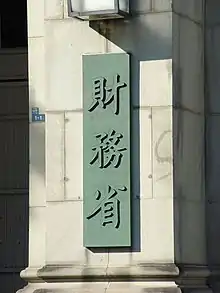Ministry of Finance (Japan)
The Ministry of Finance (財務省, Zaimu-shō) is one of the cabinet-level ministries of the Japanese government. The ministry was named the Ōkura-shō (大蔵省) until 2001. The Ministry is headed by the Minister of Finance (財務大臣, Zaimu-daijin), who is a member of the Cabinet and is typically chosen from members of the Diet by the Prime Minister.
| 財務省 Zaimushō | |
 Ministry of Finance building | |
| Agency overview | |
|---|---|
| Formed | June 1, 2001 |
| Preceding agency |
|
| Jurisdiction | |
| Headquarters | 3-1-1 Kasumigaseki, Chiyoda-ku, Tokyo, Japan 〒100-8940 |
| Ministers responsible |
|
| Parent agency | Government of Japan |
| Child agency | |
| Website | http://www.mof.go.jp |
Overview

The Ministry's originated in the 6th century, when the Ōkura (大蔵) was established as a state treasury in ancient Japan. When a modern system of government was introduced after the Meiji Restoration, the Ministry of Finance (大蔵省, Ōkura-shō) was established as a government body in charge of public finance and monetary affairs. It is said that new ministry employees are subtly reminded that the Ōkura-shō predates by some 1269 years when the new Constitution was imposed on the nation by the U.S. occupation forces in 1947.[1]
The Ministry has long been regarded as the most powerful ministry in the Japanese government. After various financial scandals revealed in the 1990s, however, the Ministry lost its power over banking supervision to a newly established Financial Services Agency. It also lost most of its control over monetary policy to the Bank of Japan when the Diet passed a new Bank of Japan Law in 1998. In addition, it lost its ancient Japanese name when it was renamed the Zaimu-shō (財務省) in January 2001, although its English name remained the same.
Despite this renaming, the Japanese people still use the older term Ōkura-daijin (大蔵大臣), meaning a person controlling a budget (e.g. housewives for family budget matters).
In financial markets, the Ministry is famous for its active foreign exchange policy. Its top civil servant on the international side, Vice Minister of Finance for International Affairs, is often quoted in the financial press. Former Vice Minister Eisuke Sakakibara was known as "Mr Yen", whereas his successors Haruhiko Kuroda and Zenbei Mizoguchi were often referred to as "Mr. Asian Currency" and "Mr. Dollar", respectively.
The current Minister of Finance is Tarō Asō.
Toshio Akagi's wife performed the signature activity of a request for a re-investigation request to investigate the truth about the suicide of a staff member of Kinki Finance Bureau of the Ministry of Finance who was forced to tamper with official documents in relation to the Mori friend case, the fastest record ever in Japan The signatures of 260,000 people gathered, resulting in a total of 300,000 signatures.[2][3]
Organizational Structure
The Ministry is organized in six bureaus that provide the overall functions of the ministry:[4]
- Minister's Secretariat
- Budget Bureau
- Tax Bureau
- Customs and Tariff Bureau
- Financial Bureau
- International Bureau
Independent Administrative Institutions
Six Independent Administrative Institutions are under the Ministry's control:
- Japan Mint
- National Printing Bureau
- National Research Institute of Brewing
- Nippon Automated Cargo Clearance System
- Commemorative Organization for the Japan World Exposition '70
- Japan Housing Finance Agency
See also
References
- Lamont-Brown, Raymond. "The Ministry: The Inside Story of Japan's Ministry of Finance – a book review", Contemporary Review. August 1998.]
- https://www.nnn.co.jp/dainichi/news/200402/20200402022.html
- https://mainichi.jp/articles/20200416/k00/00m/040/206000c
- "Functions". Ministry of Finance. Retrieved 2017-02-12.
- Hartcher. (1998) The Ministry: The Inside Story of Japan's Ministry of Finance. New York: Harper Collins. ISBN 0-00-255854-8.
Further reading
- Department of Finance. Financial and Economical Annual of Japan. Tokyo: Government Printing Office – via Hathi Trust. 1901-

